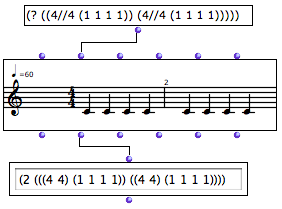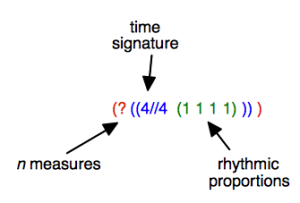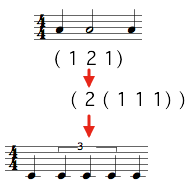Rhythm Trees Structure
Traditionally, rhythm is broken up into several data : meter, measure(s) and duration(s). Rhythm trees must enclose these information in lists and sub list.
This elementary rhythm :
![]()
can be expressed as follows :
- ( ? ( (4//4 (1 1 1 1) ) ) )
- ( ? ( ( (4 4) (1 1 1 1) ) ) )
A tree structure can be reduced to a list : (D (S)).
Main Components : Duration and Subdivisions

|  Here, the (1 1 1 1) sub list represents four equal subdivisions of a 4/4 measure. OM calculated that the tree has two measures. |
A rhythm tree has at least three levels of parenthesis :
|  |
Durations
By default, the duration of a measure is equal to 1. 1 represents the global measurement unit traditionally expressed by the time signature, such as : 4/4, 2/2 = ![]() , 3/8 =
, 3/8 = ![]() etc.
etc.

Changing this value multiplies or divides all the durations by a given coefficient.
Subdivisions : Measures and Groups
Trees define the way measures are split into proportional durations.
The following rhythm :
![]()
is written : ( ? ( (4//4 (1 2 1) ) ) ) .
Trees also define internal subdivisions, or groups1 , within a measure.
The following rhythm :
![]()
is written : ( ? ( (4//4 (1 ( 2 (1 1 1) ) 1) ) ) ) .
Note that groups must be written with a new subordinate level of parenthesis. |  |
- Group
An internal subdivision, that is, a list of proportions within a measure. A group can enclose a sub group. Basic examples are tuplets, groups of eighth, sixteenth notes. Groups of quarter, semibreves, whole notes or any other values are also admitted in rhythm trees.
For instance :
(? ((4//4 ( (2 ( 1 1)) (1 ( 1 (1 (1 1 1)))) (1 (1 1 1 1 1)) )))).
This one measure tree has one group – two quarter notes – , one group with a sub group – one eighth note and a sixteenth notes triplet, and a last group – a quintuplet.

